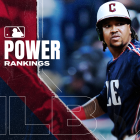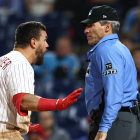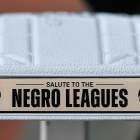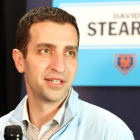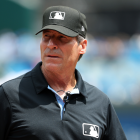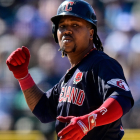
The new postseason format is designed to give more teams a chance and the Arizona Diamondbacks have taken full advantage this year. The D-backs defeated the Philadelphia Phillies in Game 7 of the National League Championship Series on Tuesday night, and they will now take on the Texas Rangers in the World Series. The Fall Classic begins Friday at Globe Life Field.
"For the entire state of Arizona, for this organization that's had a lot of hardships over the past 36, 48 months for us to be where we are right now, it was a good moment," D-backs manager Torey Lovullo said after the Game 7 win. "... We're adrenaline junkies. It's in and out of that moment. And when it hits a high and you feel it, it's a flush through your body, and it gets no better."
Two years ago, the D-backs lost 110 games, and even this season they won only 84 games with a minus-15 run differential. The 84 wins are the third fewest by a pennant winner in a non-strike, non-pandemic season. Only the 2006 St. Louis Cardinals (83 wins) and 1973 New York Mets (82 wins) reached the World Series with fewer wins than this year's D-backs.
Arizona's turnaround is largely a product of experience and natural growth, and promoting young players from within. They haven't spent big on free agents the last two years or made a string of blockbuster trades. Their biggest move these last two years is calling up likely NL Rookie of the Year Corbin Carroll, and adding him to the lineup.
That all said, the roster you see on Opening Day is never the roster that gets taken into the postseason. Every team makes changes and tinkers throughout the season, and sometimes those changes pay huge dividends and get you to the World Series. Here are four in-season moves that helped the D-backs make a surprising run to the Fall Classic.
April 20: Bumgarner designated for assignment
Ironically, the D-backs signed Madison Bumgarner four years ago so he could pitch in games like Tuesday's, a Game 7 on the road with a chance to go to the World Series. The Bumgarner signing has been an abject disaster though, enough so that the D-backs ate roughly $34 million in salary to make him go away in April. Bumgarner was released after four starts.
"I think the recent performance over the first part of the season, in totality, kind of adding up start after start, trying to live through as long as we could, knowing that we wanted it to turn around," D-backs GM Mike Hazen told MLB.com after Bumgarner was dropped from the roster. "We didn't see that as of yesterday, and so we made the decision."
Bumgarner allowed 20 runs in 16 2/3 innings in four starts this season and had a 5.23 ERA in parts of four seasons with Arizona. The former World Series MVP -- undeniably one of the best postseason performers in baseball history -- was one of the worst pitchers in baseball with the D-backs, and eventually enough was enough. Hazen and the D-backs couldn't let it continue.
Releasing Bumgarner, who the D-backs still owe $14 million in 2024, cleared the path for better pitchers to get an opportunity. It was also a statement. Your salary and your career accomplishments do not matter. If you don't perform and don't help us win, there is no room for you here. Credit to D-backs ownership for OKing the move. Eating all that money is a tough pill to swallow.
June 19: Thomas recalled from Triple-A
Entering 2022, Alek Thomas was ranked the No. 16 prospect in baseball, and he forced his way to the big leagues that May. It did not go well. Like so many rookies, Thomas struggled while also showing occasional flashes of his ability. The D-backs gave him the center field job on Opening Day this year and again, it did not go well. It went poorly enough, in fact, that Thomas was demoted to Triple-A on May 17 for the express purpose of cleaning up his mechanics.
"There's a lot of excessive movement with the lower half which is creating some force moving forward -- I know to impact the baseball -- but I feel like it was changing his sightlines," Lovullo told the Arizona Republic after Thomas was sent down. "So we want him to slow some things down. And I think it's a lower half issue more than anything. So specifically, maybe getting grounded, spreading out a little bit. Not totally eliminating the leg kick but controlling the leg kick a little bit and specifically doing better left on left."
Thomas, who is still only 23, went to Triple-A for a month and mashed -- .348/.409/.518 with six doubles and three homers in 26 games -- before returning to the D-backs in mid June. He was again installed as the everyday center fielder and the D-backs stuck with him. Thomas wasn't great, but he was much better than his previous MLB stints.
| PA | AVG/OBP/SLG | K% | BB% | |
|---|---|---|---|---|
2022 | 411 | .231/.275/.344 | 18.0% | 5.4% |
2023 before demotion | 123 | .195/.252/.327 | 22.0% | 6.5% |
2023 after recall | 279 | .245/.283/.395 | 21.1% | 3.9% |
Post-recall was his most productive stretch as a big leaguer, and he appeared to grow more comfortable as the season progressed. Most notably, Thomas started to discover his power stroke. He hit two homers before his demotion and seven homers after, and he's since added another four in 12 postseason games. That includes his game-tying two-run blast in the eighth inning of Game 5 of the NLCS.
"I've gotten to see him since 2020. You know, play with him," Carroll said of Thomas during the NLCS. "I've always seen kind of that ability to drive the ball, a special ability to drive the ball especially the other way. To see it come out right now on the biggest stage in this way, as a friend, it makes me so happy to see."
It was not until Thomas was recalled in June that the D-backs settled on an outfield alignment. Carroll was a staple, but Lourdes Gurriel Jr. split his time between left field and DH, and Arizona cycled through guys like Dominic Fletcher, Jake McCarthy, and Pavin Smith in the other outfield spot. Thomas returned, hit passably to go along with standout center field defense, and put an end to the outfield revolving door.
July 31: The Sewald trade
The bullpen and the closer's role in particular were headaches for most of the first half for Arizona. Miguel Castro, Andrew Chafin, and Scott McGough each took turns closing games early on, to varying degrees of success. Hazen solved that problem with Paul Sewald at the trade deadline. He came over in a deal that sent utility man Josh Rojas, outfielder Dominic Canzone, and prospect Ryan Bliss to the Seattle Mariners.
"It's probably one of the worst-kept secrets in terms of what our goals were coming into the deadline. We wanted to continue to help the bullpen," Hazen told MLB.com after the trade. "I think the bullpen has pitched pretty well. In the middle month there, we've struggled to close out some games in the ninth inning. It's probably some of the difference between where we're standing today and where we were standing a month ago."
Sewald has been one of the best relievers in baseball the last three seasons and he immediately gave the D-backs something they had lacked all season: stability in the ninth inning. Nothing creates agita quite like an unsettled closer's situation. Sewald was very good after the trade and this postseason he's struck out 11 batters in eight scoreless innings. He's been dominant.
With Sewald in the ninth inning, Lovullo was able to bump everyone else back into more appropriate roles. Castro and McGough took on less high-leverage work, and Kevin Ginkel was allowed to settle in as a setup man without having to occasionally be held back for the ninth inning. The bullpen came together around Sewald.
And, as an added bonus, the D-backs will have Sewald next season, as he remains under team control as an arbitration-eligible player. It's not often you can get a difference-making closer for a non-tender candidate (Rojas), a blocked outfielder (Canzone), and a second-tier prospect (Bliss). The Sewald trade was one of the best and most important of the deadline.
"We looked out on the horizon, into the offseason, and I didn't really want to be dealing with this issue in the offseason either, because it was going to pop right back around on us," Hazen told MLB.com about having Sewald in 2024. "We were going to hopefully solve a problem for this year and next. Two playoff runs at it instead of one."
Aug. 19: D-backs sign Thompson
Generally speaking, when the Tampa Bay Rays get rid of a pitcher, it means he's all used up and you should stay away. Either that or he's about to make a lot of money. In Ryan Thompson's case, the 31-year-old allowed 13 runs in 17 2/3 innings with Tampa earlier this year, and he spent a bunch of time in Triple-A. That's after a solid 3.50 ERA in 103 innings from 2020-22.
The Rays released Thompson on Aug. 19 because they needed the 40-man roster spot for a fresh long reliever. Three days later, the D-backs signed him to a minor league contract and, after a quick two-game tune-up in Triple-A, summoned Thompson to the big leagues. He allowed one run in 13 regular season innings with the D-backs, and he's been lights out in October too.
"Tampa didn't value what I brought to the table," Thompson told The Athletic earlier this month. "That was always something where you have a chip on your shoulder to prove them wrong. I felt like they let me go at a weird time, when they were in a playoff race. I felt like I could have been a big addition to their team. They let another team grab me, and I became a pretty important part of this bullpen. There's no animosity against the Rays. It's more just showing, 'This is who I am. And this could have been on your team.'"
Arizona's bullpen finished the regular season with a 4.22 ERA (18th in MLB) and 2.2 WAR (24th), but that does not tell the entire story. The bullpen they have right now, the one they took into the postseason and will take to the World Series, is much more formidable thanks primarily to Sewald and Thompson, who joined the club in the second half. Look at the bullpen's performance by month:
| ERA | Win probability added | |
|---|---|---|
April | 4.56 | +0.89 |
May | 3.54 | +0.94 |
June | 3.80 | +0.06 |
July | 6.04 | -1.35 |
August | 5.61 | -2.34 |
September | 2.31 | +2.21 |
Things got really messy in the middle of the summer, but, come September, Arizona had built one of the better bullpens in baseball. Sewald stabilized the ninth inning and Thompson was instant difference-maker after being plucked off the scrap heap. He was not even in the picture until mid-August and now he's getting huge outs in October. This is why looking at full season performance can be misleading. These late-season moves can have a big impact.
"We got guys, we got the pieces, but they hadn't yet shaped or formed. And it took a little time for us to understand what the new roles were and how people were going to be used," Lovullo said about the in-season bullpen additions. "I think once they got to that point where Paul was locking down that ninth, and we were filling it in with Kevin, and at the time it was Kyle Nelson because Andrew Saalfrank wasn't here yet, and then we picked up Thompson. It was one thing after another that fell into the right place, and once they got their roles, they took off."



















